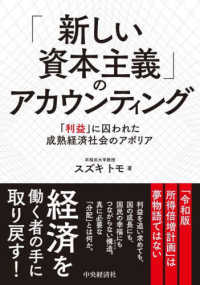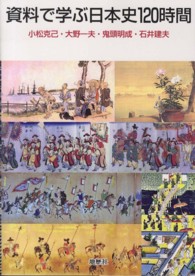- ホーム
- > 洋書
- > 英文書
- > History / World
Full Description
Excavating Pedregal offers a new synthesis of household-level experiences of imperial conquest on the north coast of Perú, using excavations at the Late Intermediate Period farming community of Pedregal as an engaging case study of archaeological research in action. Alongside this central case study, short essays by other archaeological stakeholders highlight diverse experiences and perspectives within archaeology.
This book draws on the author's 15 years of experience teaching undergraduates and over 20 years as an archaeologist in Perú to offer an accessible account of how archaeological research happens. Chapters introduce key concepts from anthropological archaeology and link research questions to methods, data analysis, and findings. The book balances a discussion of the scientific processes and anthropological theories that ground archaeological research with a tangible account of the lived experiences and practical considerations of doing archaeology. Excavating Pedregal's multivocal approach complements the central case study with vignettes by North American and Latin American archaeologists, students, and community members. These short essays enrich the main themes of the book and introduce readers to different perspectives and voices within the field, highlighting the way collaboration and conversation with multiple stakeholders enhance the study of the past.
Excavating Pedregal is an approachable introduction to how archaeology works for undergraduate students and general readers. It supplements a traditional introductory text by contextualizing research questions, methods, and data in a concrete, contemporary case study while also offering a sense of the diversity of questions, experiences, and methods that exist in archaeology today and satisfying the curiosity of those who wonder what it's like to dig up the past.
Contents
Introduction: What Is an Archaeologist and How Did I Become One? 1 What Do Archaeologists Want to Know about the Past? 2 Reasoning like an Archaeologist: Connecting Questions to Evidence 3 Who Cares about Archaeology and Why? Archaeology's Stakeholders 4 How Do You Know Where to Dig? Surveying Regions, Landscapes, and Sites 5 Brushing Dirt Off of Other Dirt: Excavating Archaeological Sites 6 Making Sense of Time, Space, and Artifacts 7 Corn, Fish, and Conquest: Analyzing Plant and Animal Remains 8 Tools of the Trade: Ceramic Pots and Stone Implements as Culinary Technologies9 Reading the Bones: Bioarchaeology of Cuisine, Identity, and Experience under Chimú Rule 10 Conclusions, Conversations, and New Directions







